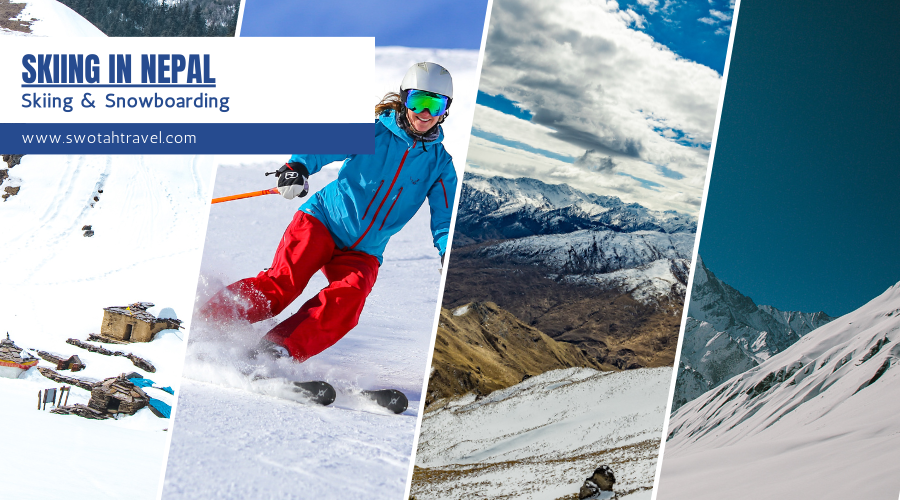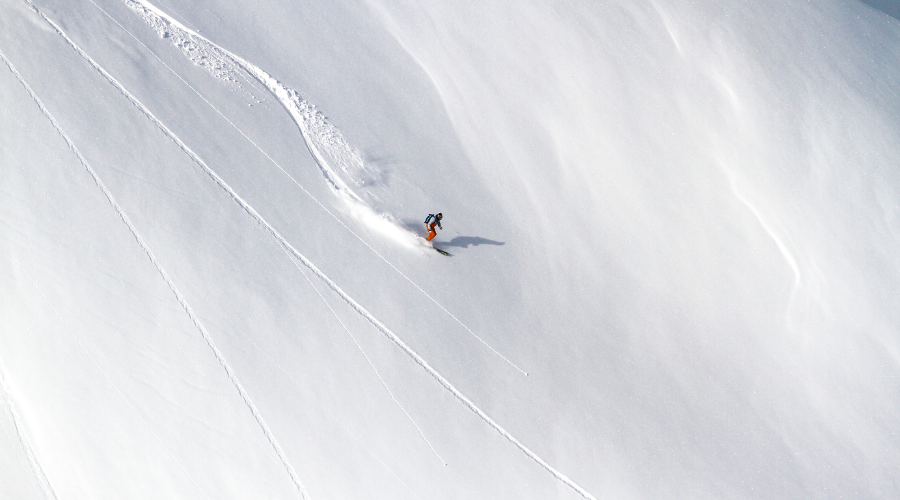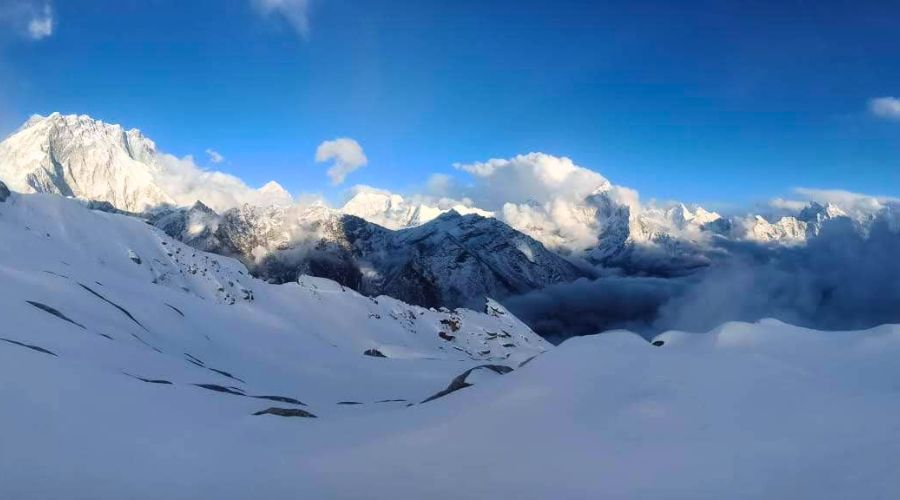
Best Places for Ski in Nepal

Best Places for Ski in Nepal
swotah travel
1927
18, 04 2024
Skiing is a thrilling sport that is especially enjoyed during the winter season. It involves gliding/sliding down snowy slopes or mountains using skis. Skis are long but narrow boards that are slightly turned upward at one end and are attached to the ski shoes or ski boots. Ski boards and ski poles are used together to navigate the way and increase or decrease speed. Nepal is home to 10 mountains, among 14 of the 8000 m / 26246.72 ft plus found in the world and has one of the best natural geographical cutouts for skiing. In recent years, skiing and heli-lift skiing have gained popularity. Studies have shown that Nepal can easily be at the top of the list for high-altitude ski adventures. In recent years, ski tourism has become a topic of discussion among adventure lovers. Mountaineering to the top of the mountain and skiing down with breathtaking sights around has to be one of the best adrenaline-filled experiences to exist, after all.

In this article, we will delve into the best places for skiing in Nepal, exploring the top destinations that promise thrilling adventures on the slopes.
Kalinchok: A Skiing Haven in Dolakha
Kalinchowk, located in Nepal's Dolakha district, is gaining popularity as a skiing destination due to its proximity to Kathmandu and stunning natural scenery. Situated about 150 kilometres east of the capital, visitors typically access Kalinchowk via Charikot or Kuri Village, with options to hike or take a cable car up to the summit.
The skiing area, set between 3,000 and 3,800 meters in elevation, primarily offers off-piste skiing suitable for both novices and seasoned skiers. The best skiing conditions occur from December to February when the area experiences moderate to heavy snowfall. Visitors should be well-prepared for the cold and windy weather during these months.
Accommodations are mostly available in Kuri Village, providing basic to comfortable amenities for a pleasant stay. A notable feature of Kalinchowk is its ski school, which offers training sessions for all skill levels, from basic techniques to advanced maneuvers, ensuring a comprehensive and enjoyable skiing experience.
Besides skiing, Kalinchowk is known for the Kalinchowk Bhagwati Temple, which offers panoramic views of the Himalayan range and opportunities for snowboarding and trekking. Due to the area's remote and rugged terrain, visitors are advised to be well-prepared and consider exploring with an experienced guide.

Annapurna Base Camp: Backcountry Skiing at its Finest
Annapurna Base Camp (ABC) invites adventurers to experience unparalleled backcountry skiing in the majestic Annapurna range. Nestled in the Himalayan landscape, ABC features a variety of skiing terrain, from beginner-friendly gentle slopes to challenging routes for experienced skiers.
Although avalanches sometimes pose risks, ABC remains a sought-after destination for ski and splitboard training. It offers a thrilling blend of adventure and tranquillity in the Himalayan setting.
ABC skiers enjoy a diverse range of experiences, including exhilarating descents through untouched powder fields and tranquil moments surrounded by towering peaks. The region's unique geography provides numerous skiing options, from expansive bowls to narrow couloirs, making every run an unforgettable adventure.
Beyond exceptional skiing terrain, ABC also provides comfortable lodging and warm hospitality. Weary travellers can relax in cozy mountain lodges after a day on the slopes, enjoy hearty meals, and share stories of their mountain exploits.
For those looking to explore beyond the slopes, ABC offers ample opportunities for trekking, mountaineering, and cultural immersion. Skiers can take guided tours to nearby villages, visit ancient temples and monasteries, and engage with local communities to discover the rich cultural heritage of the Himalayan region.
Other Notable Places
While popular sites such as the Kalinchowk and Annapurna regions are well-known among the skiing community, several other areas in Nepal offer unique and exhilarating skiing opportunities.
One such area is the Mustang region, often referred to as the "Last Forbidden Kingdom." Its remote, arid landscape provides a stark contrast to the snow-covered slopes, making for a dramatic and memorable skiing experience. The region's high altitude and dry weather conditions ensure good snow quality, which is ideal for both skiing and snowboarding.
Further west, the Dhaulagiri and Manaslu regions offer some of the most challenging terrains for ski adventurers. These areas are less frequented by tourists and retain a sense of untouched wilderness, perfect for those looking to ski in solitude amidst nature. The slopes in these regions are steep, and the snow conditions can vary, presenting an exciting challenge for experienced skiers.
Additionally, the Putha Hiunchuli area, part of the Dhaulagiri mountain range, is gaining popularity for ski mountaineering. This region offers a unique combination of climbing and skiing, where adventurers can ascend using climbing skins and then enjoy a thrilling descent on untracked powder.
Finally, the Humla and Simkot Valley in the far northwest of Nepal are emerging as potential ski spots. These remote areas are challenging to access, but reward the intrepid skier with pristine landscapes and virtually untouched slopes.
How much does it cost to ski in Nepal?
Although it is not certain how much you will spend on skiing in Nepal, as it depends on various factors, from the location to gear and equipment to the duration of skiing, here is a rough estimation.
-
First, the cost of a ski permit is USD 1000 for the first ten people and USD 100 if more members are added per individual.
-
Second is the cost of a lift ticket: a ski lift ticket costs approximately USD 20 to USD 60 or more.
-
Ski equipment: If you do not have your own ski equipment, it is not wise to buy all of it; instead, renting it is a good option. To rent all the necessary ski equipment, it costs around USD 20 to USD 50 per day.
-
There are a few ski rentals around Kathmandu (especially the Thamel area), Pokhara, Kuri (Ski rental boutique Nepal), and many online rental platforms as well. For those who need to become more familiar with these places, it is better to get help from travel agencies on renting ski gear. If you opt for a guided ski tour, then the company is in charge of taking care of these things.
What is the best time to ski in Nepal?
The perfect time for skiing in Nepal is from October to December. Around this time of the year, there is a lot of snow piled up in the mountains, and the skies are clear. The more snow there is, the better the skiing experience. Skiing in the Himalayas in these months is not any lesser than visiting a winter wonderland. Well, these were the best months, but you can also ski in Nepal during early spring (March, April, and early May).
Although there is not as much snow as in winter, there is enough for a good ski experience. By the end of May, the temperature will increase a lot, and the snow level will decrease in most of the mountain regions. In the summer season (June, July, and August), skiing is not safe and doable due to heavy rainfall. The skies are not clear most of the time, and skiing in the rain is calling for hazards. So, it is best to avoid the summer / rainy season.
Are Ski permits needed to ski in Nepal?
The answer is yes. One needs permits to ski in Nepal. Ski permits cost $1000 for the first ten mountaineers, and each addition to the group is eligible to pay $100. Ski groups can have a maximum of 20 people and are valid for ten days. The year 2018 had a big facade after two American mountain climbers, Willy Benegas and Matt Moniz, skied down Mt.Everest without any permit from the government.
They did say they were unaware of any permits existing in the first place. However, this led to authorities saying they were going to be banned from climbing Mt.Everest and Mt.Lhotse. However, they were quick to react and did not hesitate to pay the required cost. So, to avoid such hassle, make sure to get your permits before opting for skiing in the majestic Himalayas.
Note: Some places in Nepal, like the Annapurna region, Langtang Valley, Mustang, etc., do not require ski permits. However, policies are always changing, so it is suggested that you confirm with the authorities from the place you are looking to ski and get the required permits.
What are the clothes, gear, and types of equipment needed for skiing in Nepal?
-
Ski jackets that are waterproof with synthetic insulation.
-
Long fleece woollen tops to layer underneath.
-
Less heavy middle layer and outer layer for comfortable body movements.
-
Ski pants or Bibs
-
Ski socks (these socks are longer than the normal socks and have the right amount of thickness as overly thick socks can do more bad than good when it comes to skiing)
-
Warm, waterproof gloves keep your hands protected. It is important to have your hands warm and properly functioning at all times while skiing.
-
Ski helmets to prevent head injuries in case you collide, fall a pile of snow falls on you, and of course, keep your head warm.
-
Goggles to protect your eyes from cold and snow debris.
-
Neck gaiter (keeps your neck warm and protected. Can be used even pulled up to your nose)
-
Skiing skis (ski boards)
-
Skiing pole
-
Skiing boots
-
Ski backpack (not mandatory, but carrying a ski bag allows you to carry things you need like sunscreen, lip guard, snacks, first aid, etc)

Skiing in Nepal with Swotah
Skiing in Nepal offers a unique blend of adventure, natural beauty, and cultural richness, making it a top choice for enthusiasts looking to explore off-the-beaten-path slopes. Swotah Travel and Adventure, a specialised tour operator based in Nepal, provides expertly crafted skiing expeditions across various regions of the Himalayas, ensuring a thrilling and authentic experience.
Swotah leverages its deep local knowledge and extensive network to offer tailored skiing tours that cater to different skill levels and preferences. Their tours are designed to combine skiing with cultural immersion, giving you a chance to interact with local communities and learn about Nepali customs and traditions. Safety is a top priority for Swotah, with experienced guides and the latest equipment to ensure a secure and enjoyable experience.
What can be done to improve skiing in Nepal?
-
Improve accessibility in the skiing spots.
Places like Manaslu, Dhaulagiri, the Annapurna region, etc., are lagging in the ski tourism industry because of their hard accessibility. Kalincowk, on the other hand, has been thriving as a ski spot due to its easy accessibility. So, if access to ski spots in the Himalayas is improved, then the change will be visible in ski tourism within no time.
-
Domestic as well as international sports competition
Even though Nepal has great capacity in ski only few around the world know about it. Nepal has endless possibilities in ski sector and it should be shown to the world. Domestic and international ski competitions are the best way to do that. Doing so not only gives exposure to the ski places in Nepal but also uplifts the nation’s economic status.
-
Infrastructural development
Let us be honest: The government of Nepal and the tourism board have been sleeping on skiing development. People who are interested in skiing in the Himalayas do not have it easy as of now. There are no proper infrastructural facilities, there are limited resorts, and very, very limited services are offered. If these things are taken into consideration and improved, then it can do wonders in the skiing sector.
-
Improve safety measures
Well, it is no surprise that there are no serious safety measures, given that infrastructures are lagging. In sports like skiing, safety should be the first priority. If one does not feel safe, then they are sure not to ski in Nepal.
-
Training and certifications.
There are few places in Nepal that provide ski training. Still, skiing is very much a foreign sport for Nepalese. They need to have a place for proper training and certifications to boost them to do better. After all, improvements start from within.
-
Local communities engagement
Locals living in and around the Himalayas should take the initiative to establish and manage ski resorts. This will help them with their economic state as well. Community involvement is the best way to capitalise on ski tourism.
-
Collaborations
Nepal’s government should seek collaboration with different international ski companies. They need to exchange knowledge, discuss the benefits both parties receive, and form partnerships.
-
Marketplaces for ski types of equipment and gears
It is not very handy to carry all the ski gear and types of equipment in every place you go. The lack of shops for these gears around spots known for skis does not help. So, more places with all the supplies should be opened in different places for the ease of the tourists.
-
Better insurance policies
More insurers with better policies and coverage are needed for skiing.
NEWSLETTER SIGNUP
Sign up to receive our trip ideas and travel offers!
Get updates and Exclusive Offers up to 20% Discount








